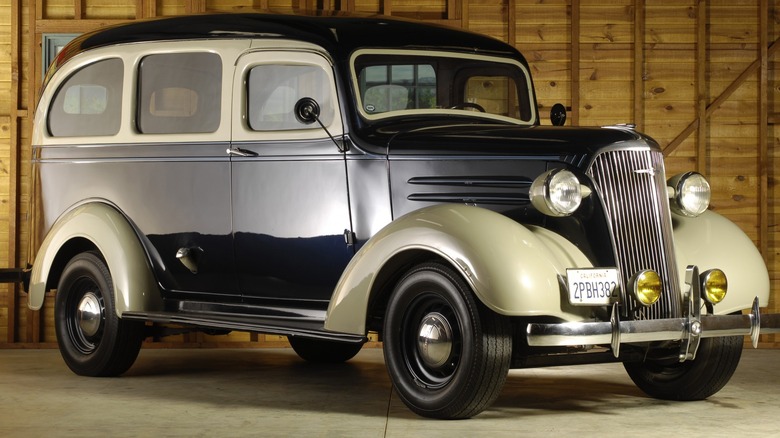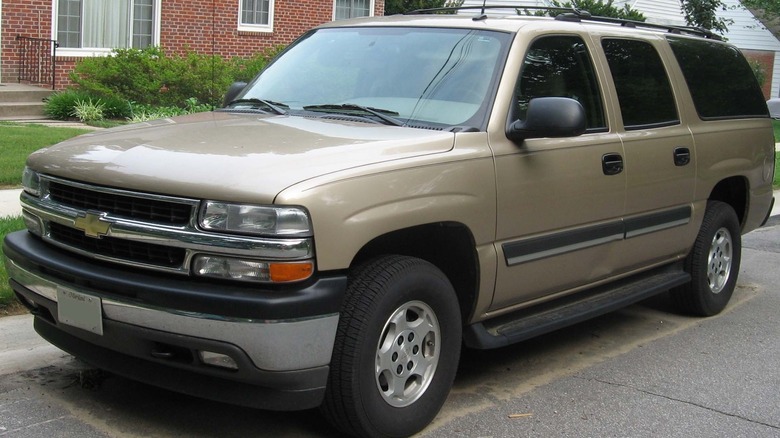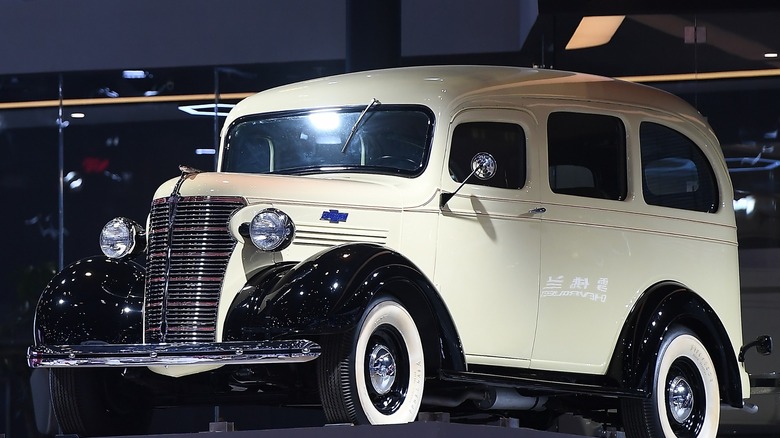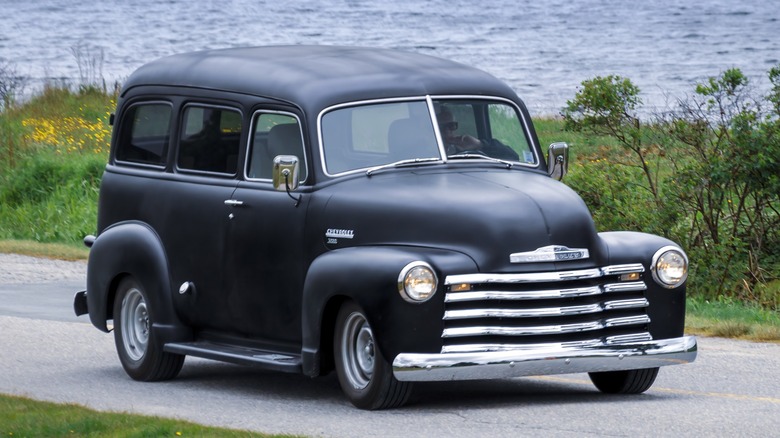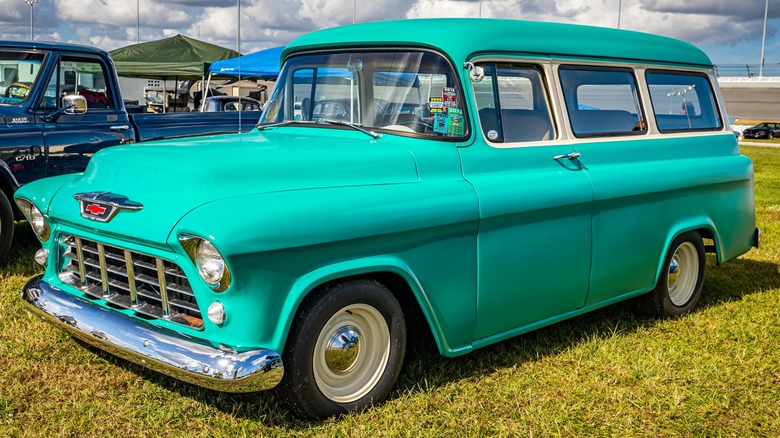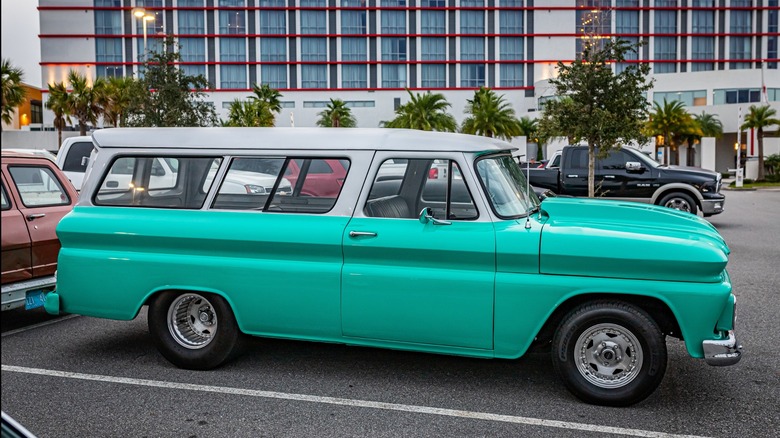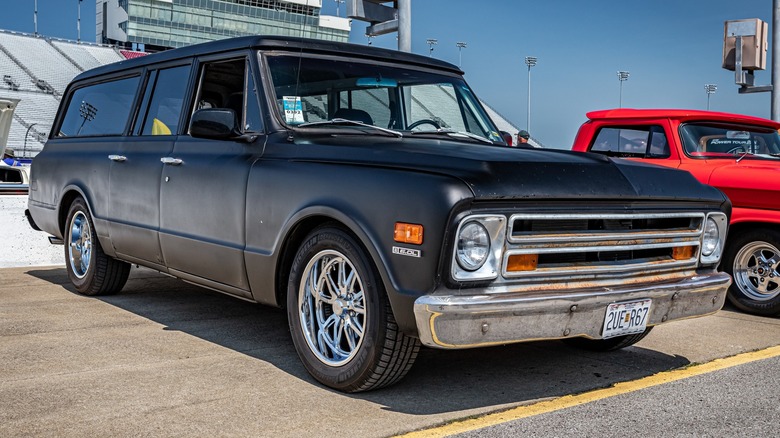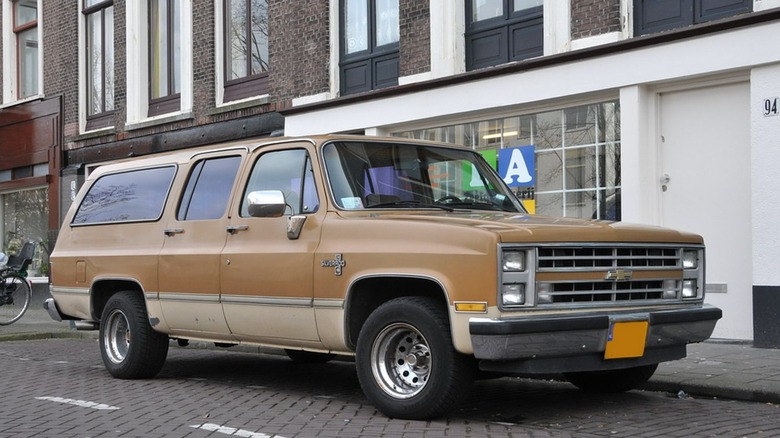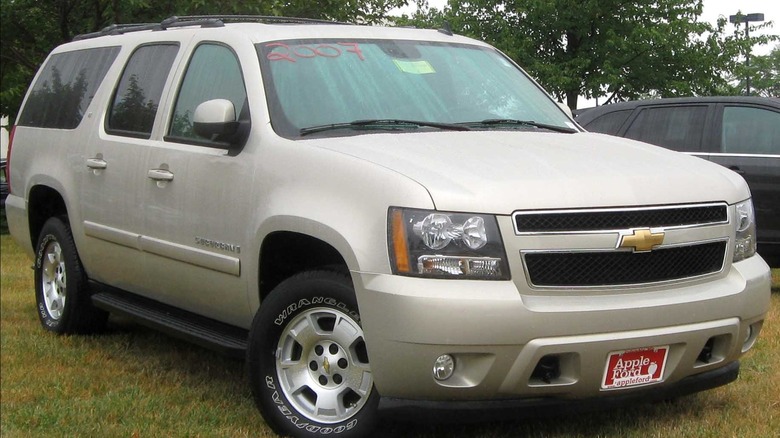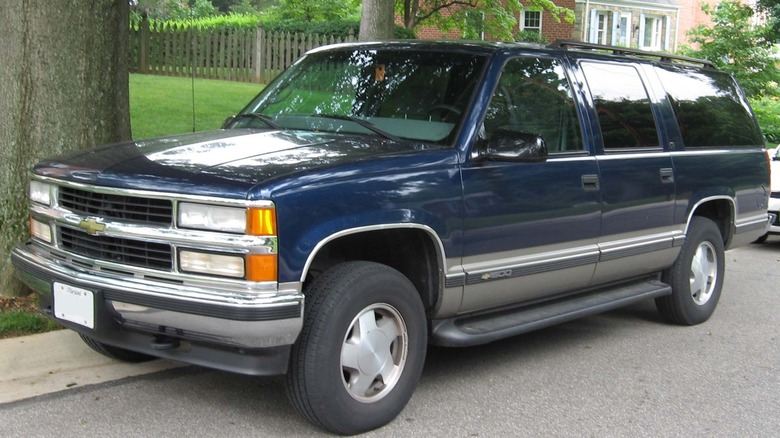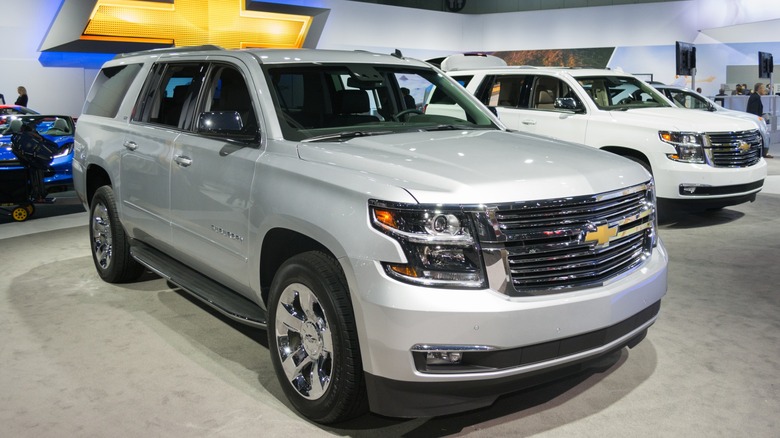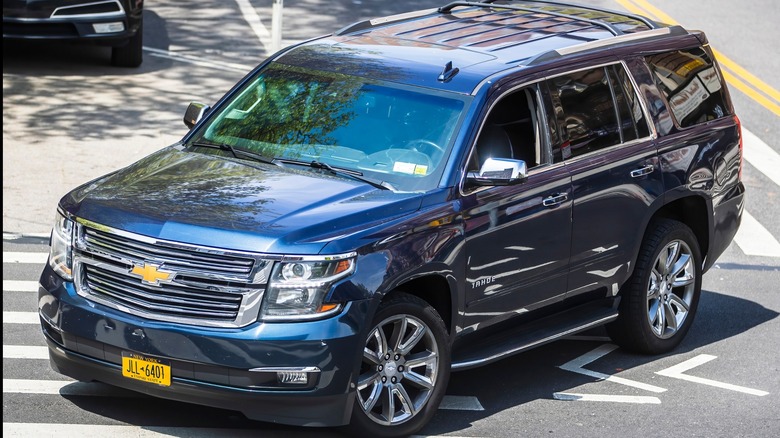Every Generation Of Chevrolet Suburban Ranked Worst To Best
In the early 1930s, the name "Suburban" referred to a classification of vehicles featuring a windowed body similar to a modern-day station wagon. Brands such as Dodge, Plymouth, and Studebaker manufactured models with the Suburban style. When Chevrolet introduced its steel-bodied, eight-passenger truck-based wagon in 1935, the Suburban nameplate seemed appropriate for the full-size, extended-length Sports Utility Vehicle (SUV).
The Suburban has evolved over the years making changes and incorporating new technology to improve power output, road handling, and passenger comfort. While the base model Suburbans offer an average-performing suspension, the optional magnetic dampers give the SUV a smooth Cadilac-type ride. For off-roading, Chevy now offers the Z71 trim with exceptional capabilities for challenging dirt and mud roads. However, the SUV has one feature that remained constant through the years: its massive size. The current Suburban models offer three rows of comfortable seating for up to eight passengers and have a cargo space that exceeds that of the Jeep Wagoneer by an impressive 20 cubic feet when both vehicles have their third-row seats folded.
Car and Driver calls the Chevy Suburban the quintessential American vehicle: "big, brash, potent, and pragmatic." Recent vehicle sales back up this claim. In 2021, Chevrolet sold 48,214 Suburbans, and in the following year 50,951 vehicles, a gain of 5.68%. Although the Suburban has demonstrated progress with each new generation, some have been more successful than others.
Based on innovative features introduced, auto industry reviews, NHTSA statistics, and owner feedback, here is every generation of the Chevrolet Suburban ranked from worst to the best.
12. Chevrolet Suburban Second Generation 1941 - 1946
The second-generation Suburban ranks as the worst for its low production and lack of new features. During World War II, the manufacture of military products and vehicles for the war effort severely impacted the production of automobiles available to the public, and the Suburban was no exception. Chevrolet produced nearly 3,000 armored cars, manufactured aircraft engines, gun parts, and shells, and worked as a Grumman Aircraft subcontractor on wing sections and fuselage components. The automaker's commitment to military vehicles and equipment limited the commercial production of new second-generation Suburban models to the years 1941, 1942, and 1946.
During the war years, Chevrolet offered two variants for the Suburban, one with rear panel doors and the other with tailgates replacing the panel doors. However, when American auto manufacturers reverted back to making automobiles from war materials in 1946, they had no designs for new models. Production instead resumed with the 1942 models.
The 1946 Chevrolet Suburban's exterior styling was identical to the 1942 form, and the early units even lacked war-rationed chrome trim, but it showed up again on the vehicles produced later in the year. The same Stovebolt six-cylinder engine provided the power, albeit with a slightly greater displacement of 228 cubic inches and a higher output of 90 hp at 3,300 rpm and 165 lb-ft at 1,000-2,000 rpm. Power was sent to the rear wheels via a three-speed manual transmission and Chevy continued offering hydraulic brakes as standard equipment.
11. Chevrolet Suburban Ninth Generation (GMT800) 2000 - 2006
Chevrolet built the massive ninth-generation Suburban on the same robust chassis used for the GMC Silverado and Sierra pickup. The rugged SUV tackled dirt roads laden with holes and ruts, conquered challenging offroad terrain, and pulled heavily loaded trailers. However, the Suburban's performance on winding roads was mediocre, and no buyers selected the vehicle for its fuel efficiency. In 2000, Chevrolet completely redesigned the Suburban offering better road handling from a more ridged frame, an upgraded interior, a 5.3-liter V8 engine producing 285 hp in the 1500 model and a 6.0-liter V8 generating 300hp in the heavy-duty 2500 weighing 5,760 pounds.
But what makes the ninth generation rank low on the list of best Suburbans are the brakes. Owners reported a variety of issues including failure to work properly, the short brake pad life of three to four months, vibrations, noise, and an anti-lock braking system (ABS) that activates without warning. The NHTSA website registered several reports on the brakes. "When driving at any speed and applying the brakes, they freeze up, one report said. "Brake pedal is barely touched and brakes lock instantly causing occupants to jolt forward ABS is working intermittently."
Another report noted that the brakes failed completely, with the pedal hitting the floor after pulling into a parking lot with no rebound.
[Featured image by IFCAR via Wikimedia Commons | Cropped and scaled | Public Domain]
10. Chevrolet Suburban First Generation 1935 - 1940
The first-generation Chevrolet Suburban has its roots in an eight-seater vehicle made with a wooden body mounted on a half-ton truck frame. The vehicle was first built in 1933 for the National Guard and Civilian Conservation Corps units. In 1935, Chevrolet introduced the first Suburban to the public, a rugged, no-nonsense load-carrying model featuring an all-metal station wagon body fitted with either rear panel doors or a tailgate on the chassis of a small truck. Although many consider it to be the first SUV, the Suburban was still a commercial vehicle. Passenger car features such as a heater, dual windshield wipers, a clock, and a radio were offered as options.
The early first-generation Suburban came in a two-door body style with a 3.4-liter inline six-cylinder "Stovebolt" engine (so-called for its large, slotted-head fasteners that resembled those in popular wood-burning stoves), producing 56hp. In 1937, Chevy upgraded the engine to 79hp at 3,200 rpm and a maximum torque of 140 pound-foot at 1,000-2,000 rpm. Power was sent to the rear wheels via a three-speed manual transmission.
In addition to the ample passenger seating, the foldable second-row and removable third-row seating provided the Suburban with a maximum of 115.1 cubic feet of cargo space. In 1936, Chevrolet improved safety by introducing hydraulic brakes, and in 1937 the body was streamlined with an Art Deco styling. Although the first generation could be considered one of the best, mainly because it introduced the Suburban which became the Chevy's longest-running production vehicle, without interruption, its features pale in comparison to other generations.
9. Chevrolet Suburban Third Generation 1947 - 1954
Chevrolet introduced the third generation Suburban with its "Advance Design" styling used on the Chevy truck line, although it displayed many of the vehicle's traditional design characteristics employed since 1948. The exterior featured a sloping windshield, wide horizontal grille bars, running boards, and a massive hood that made the huge front fenders seem just a bit smaller. Like the previous generation, the new Suburbans offered the two-door body style with access to the cargo area either by a pair of "barn" doors or a tailgate. More cargo space became available with the removal of the second and third-row seats, mounted on a linoleum-covered floor.
While Chevrolet promoted the third-generation Suburban with plenty of decorative chrome on the exterior including the front grille, the impact of material shortages caused by the Korean War resulted in the production of most vehicles with painted grilles. Although the Suburban still rode on a pre-war designed chassis and suspension, double-acting shock absorbers helped improve the SUV's ride. Perhaps the most significant technology introduction of the third generation was "flow-through ventilation." This predecessor to air conditioning improved driving comfort.
The SUV was powered by the cast iron Chevy Thriftmaster inline six-cylinder engine, displacing 3.8 liters and producing 92 hp at 3,400 rpm, and 176 pound-foot of torque at 1,000-2,000 rpm. The maximum torque achieved at low engine rpm gave the Suburban a feeling of rapid acceleration at startup and exceptional towing capacity. The Advance Design Suburbans had torque-tube-type driveshafts with stationary housing designed to hold the rear end in place during acceleration and braking.
8. Chevrolet Suburban Fourth Generation 1955 - 1959
In 1955, when American passenger cars were characterized by avant-garde styling with fins (like the 1957 Chevy) and chrome everywhere, Chevrolet introduced the Suburban with a radical new modern smooth-sided "Task Force" body style. It deviated from the traditional heavy-looking third-generation models with rounded fenders and a dominant hood. The new Suburban eliminated the old running boards, featured a body flush with the fenders, and hosted a wraparound windshield.
The fourth-generation Suburban carried eight passengers and the choices for the rear doors remained the same as the previous models with the side-hinged swing doors or tailgate with lift-up rear window. Often referred to as the "second series" design, the new generation featured several new technologies. Chevrolet implemented a 12-volt electrical system, a Posi-traction rear axle, and installed tubeless tires. The automaker still fitted the Suburban with a standard 235 ci six-cylinder engine with a 7.5:1 compression producing 119hp, but it also offered, for the first time, a V-8 with its new 265 ci small block mill generating 154 hp. In 1955, Chevy offered the standard three-speed manual transmission but added an optional four-speed manual and a four-speed Hydra-Matic automatic.
In 1957, Chevy introduced factory-installed four-wheel drive with the Northwestern Auto Parts Company (NAPCO) "Power-Pack", an aftermarket system previously purchased by American truck owners for $995 when no 4x4 version was offered. The upgrade was available only on models with open (non-torque tube) driveshafts. The agreement between GM and NAPCO lasted until 1959 when the automaker began offering its own four-wheel drive system.
7. Chevrolet Suburban Fifth Generation 1960 - 1966
The fifth-generation Suburban Carryall body style mimicked other Chevy trucks of the era with sharper lines and two oval ports above the headlights forming twin eyebrows. Chevrolet flattened the hood and added a wrap-around windscreen, popular on passenger cars. Access to the cargo area options remained the same as the previous generation with side-opening doors or tailgate with lift-up rear window.
New features included a new robust ladder-type frame (introduced in 1963), and a fully independent front torsion bar suspension. The upgrades gave the Suburban improved road handling and passenger comfort on the highway and the optional four-wheel-drive provided the SUV with excellent off-road capabilities for a vehicle of its size. In 1965, Chevrolet added several passenger comfort and safety features including air conditioning, rear area heating, safety belts, backup lights, and dual-speed windshield wipers.
Chevrolet offered the fifth-generation Suburban with seven power options: four inline six-cylinder engines, a V-6, and two V-8s. The inline six-cylinder engines evolved from the original Stovebolt engine which had proven to be durable and reliable. A 235 ci (3.9-liter), 230 ci (3.8-liter), 292 ci (4.8-liter), and 250 ci (4.1-liter) engine were used from 1960 to 1966. The 305 ci (5.0-liter) V-6 was one of the first V-6 engines produced by a U.S. auto manufacturer. The first iteration produced 150hp at 3,600 rpm with 260 pound-foot of torque at 1,600 rpm. Chevrolet upgraded a subsequent version of the powerplant to 165 hp at 3,600 rpm and 280 pound-foot of torque at 1,600 rpm.
6. Chevrolet Suburban Sixth Generation 1967 - 1972
Chevrolet made significant changes to the Suburban in 1967 starting with a new platform also used on the C/K pickups. The truck demonstrated features characteristic of most SUVs in the early '70s. These included a more comfortable ride using rear coil springs and an independent front suspension on rear-wheel drive models, and a leaf spring-based solid axle setup on the four-wheel drive models. Creature comforts, and conveniences typical of a standard sedan were offered to compete with other SUVs in its class and attract buyers looking for a daily driver.
Chevrolet restyled the Suburban, reducing the round lines from earlier generations and reconfiguring the doors. A single rear door was added to the passenger's side for a total of three doors, making access to the rear cargo area easier. The vehicle became a popular choice for ambulance companies. The wheelbase increased to 127 inches, which improved cabin space, significantly increased the cargo-hauling capability, and enhanced its towing capacity. A heavy-duty, three-quarter-ton chassis was added to offer buyers even more hauling capability.
By 1972, the final year of the sixth generation, a host of convenience and safety features had been added including a dual-cylinder brake system with front disc brakes, a thick laminated safety glass windshield, a padded instrument panel, and an energy-absorbing steering column to reduce driver injury during impact. However, power steering and power interior accessories were still optional. The inline six-cylinder remained the standard, but Chevy made several small-block V-8s (283, 307, 327, and 350 ci) and both 396 ci and 402 ci big-block engines available.
5. Chevrolet Suburban Seventh Generation 1973 - 1991
The seventh-generation Suburban lasted 19 years, the longest of any in the SUV's history. Although car manufacturers generally begin a new generation to mark significant changes to a model, Chevy introduced a few noteworthy innovations during its seventh. The automaker focused on new features to attract customers looking for a personal vehicle with a large passenger capacity and cargo space.
In 1973, Chevrolet introduced the 7th Generation Suburban with a 12-inch longer wheelbase (129.5 inches) and for the first time a conventional four-door body style, The additional door along with step-up plates made passenger entrance and exit easier. Front and rear air conditioning plus third-row heating made travel pleasurable for any weather conditions. In 1975, Chevy upgraded the cabin with wood grain dash inserts, fully trimmed door panels, and more comfortable seats made with simulated buffalo hide vinyl upholstery. A luggage rack was added for long trips and ride quality was significantly enhanced with rubber front control arm bushings and new rear leaf springs to absorb impact on rough roads. Pavement and off-road handling improved with the use of an Eaton locking rear differential.
During the seventh generation, Chevrolet offered the Suburban's first ¾-ton passenger version and diesel power with a GM 350 V-8, and later a 6.2-liter from Detroit Diesel. Buyers had the choice of ordering the three-quarter-ton model, fitted with a 454 ci big-block engine that produced 335 pound-foot of torque. In 1987, the engine gained fuel injection with output climbing to 255hp and 405 pound-foot of torque.
[Featured image by FaceMePLS via Wikimedia Commons | Cropped and scaled | CC BY-SA 2.0]
4. Chevrolet Suburban 10th Generation (GMT900) 2007 - 2014
Chevrolet modified the Suburban body style in 2007 making the SUV more aerodynamic, and in tune with the current body style trends. Although no shortage of chrome existed in 2007 as it had after WWII and the Korean War, Chevrolet removed the metal from the bumpers. The automaker implemented several safety features including dual-stage front airbags with deployment determined by crash severity. The passenger seat safety system can disable the front airbag when it senses the presence of a child riding in the front seat. The new Suburban also offered driver assists and digital safety features including Side Blind Zone Alert, electronic trailer sway control, and Hill Start Assist.
Although the 10th-generation Suburban offered attractive new features, the model suffered from a few problems, prompting CarComplaints.com to advise potential buyers to "beware of the clunker." Common problems included engine failure, active fuel management malfunction, and transmission malfunction with improper shifting. The most common problem on all models was the infamous Takata airbag. The recalled faulty airbags were prone to exploding with potentially fatal consequences.
Excessive oil consumption was another common complaint. One customer reported: "Excessive oil consumption. Vehicles use 2 quarts of oil every 3000 miles. This is a known manufacturer defect, yet they are making me pay for the repairs." Another buyer mentioned the vehicle had numerous engine issues and abnormal oil consumption.
[Featured image by IFCAR via Wikimedia Commons | Cropped and scaled | Public Domain]
3. Chevrolet Suburban Eighth Generation (GMT400) 1992 - 1999
Although the Suburban is widely recognized as one of the first SUVs dating back to 1948, the eighth generation introduced in 1992 helped ignite the SUV boom of the '90s. The GMT400 architecture featured all-new styling, a smooth ride with a torsion-bar independent front suspension for the full-time Insta-Trac 4WD models, four-wheel anti-lock brakes, and a more powerful 6.5L Detroit Diesel option. The eighth generation was the first to get PassLock security, Onstar, and a driver's side airbag.
The two best years of the 8th Generation were 1993 and 1995. Only subtitle differences distinguished the body styles of each year, but both seemed outdated compared to other SUVs on the market, such as the 1993 Jeep Grand Cherokee. Chevrolet offered the same base model engine in both 1993 and 1995. The 5.7L V-8 produced 210 hp at 4000 rpm and 300 lb-ft torque at 2800 rpm mated to a four-speed automatic transmission. While the Suburban is not built for speed, the SUV accelerates to 60 mph in 10 seconds, sufficient enough to pass slow-moving trucks on the highway.
Both Suburban model years are well-known for their towing capacity and reliability. The 1993 and 1995 Chevrolet Suburban 1500s have a towing capacity of 6500 lbs. Both models have received few customer complaints, and many owners have reported reaching nearly 450,000 driving miles before any high maintenance cost issues occur, making it one of the most desirable SUVs on the used market today.
[Featured image by IFCAR via Wikimedia Commons | Cropped and scaled | Public Domain]
2. Chevrolet Suburban 11th Generation (GMTK2YC/G) 2015 - 2020
The introduction of the Rally Sport Truck (RST) Performance Package for the Chevrolet Suburban in 2018 added significant power and performance to the 11th generation, pushing it near the top of this list. Chevrolet offered several drivetrain options for the standard Suburban: a 5.3-liter V8 Variable Valve Timing (VVT) producing 355hp mated to a six-speed automatic, the same engine mated to a ten-speed automatic sending power to all four wheels, and a 3.0-liter diesel generating 277hp connected to a ten-speed automatic. The RST upgrade included a 6.2-liter V-8 engine that generated 420hp and 460 pound-foot of torque connected to a standard 10-speed automatic.
According to Motor Trend, the RST reaches 60 mph in the range of six seconds, and boasts an 8,100-pound towing capacity. The three-row RST provides seating for up to eight passengers, a huge cargo capacity, and other upgraded features such as a 3.23 rear axle ratio and a two-speed active transfer case (4WD model only).
The RST appearance package has less chrome than the standard model and features a unique gloss black sport grille, body-color door handles, and headlamp accents. Gloss black aluminum wheels (22 inches) are accented with custom silver inserts. Perhaps the most significant improvement is the active Magnetic Ride Control suspension. The system senses variations in road conditions every millisecond and sends signals to electronically controlled shock absorbers to adjust damping. The sophisticated suspension improves handling with body-motion control during cornering and provides a more comfortable ride.
1. Chevrolet Suburban 12th Generation (GMT1YC) 2021 - Present
Chevrolet's largest SUV, the 12th-generation Suburban, has a longer wheelbase than previous generations and is even more spacious than its predecessors. It has the most passenger and cargo space of any SUV in its segment. The new interior has lower load floors that provide a more comfortable seating position and create a third-row legroom gain of 10 inches, plus more cargo space. HD Surround Vision and a new rear-seat media system further enhance the road trip experience.
Built with the same body-on-frame underpinnings as the Silverado pickup, the SUV now rides on a new platform featuring a multilink independent rear suspension for a more comfortable ride. New Chevy Suburban safety technologies include a Rear Pedestrian Alert and HD Surround Vision system, and the 2023 Suburban offers Super Cruise, GM's Level 2 autonomous driving technology.
Chevrolet offered the 12th-generation Suburban with several drivetrains: a 5.3-liter V8 VVT 10-speed automatic AWD producing 355hp, a 5.3-liter V8 VVT 6-speed automatic RWD generating 355hp, and a 6.2-liter V8 VVT 10-speed automatic producing 420hp. The automaker also offered a 3.0-liter diesel engine coupled to a 10-speed automatic producing 277hp and 460 pound-foot of torque. While the Suburbans powered by a gasoline engine are notorious for poor fuel efficiency (15/19 mpg city/highway), the diesel engine gives the SUV the best fuel efficiency in its class. The Suburban is also available in the Z71 trim featuring 4WD standard, and off-road accessories such as skid plates, a two-speed transfer case, with all-terrain tires mounted on 20-inch alloy wheels and front-rear tow hooks.
